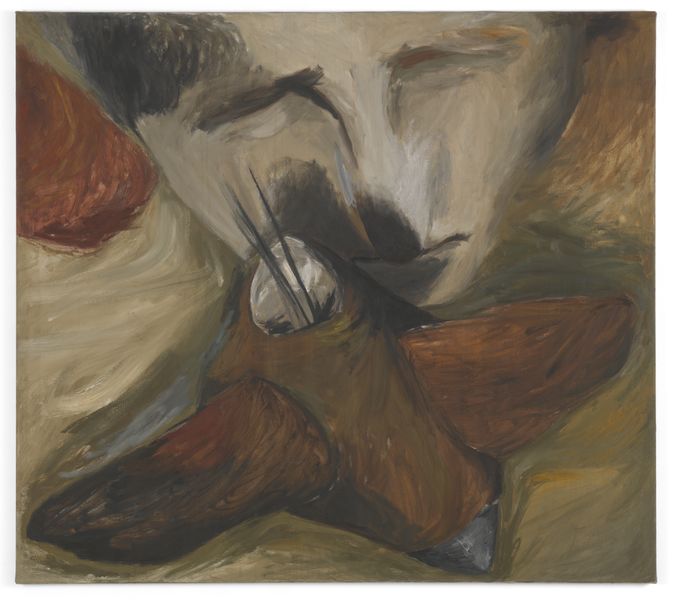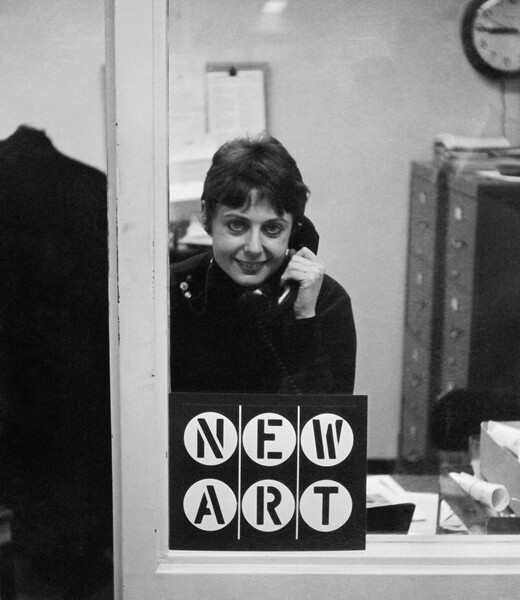Teachers’ Notes: ‘Lee Lozano’

Lee Lozano, No title, 1962-1963, Oil on canvas, 30.8 x 41 cm / 12 1/8 x 16 1/8 in, Courtesy Private Collection, Photo: Stefan Altenburger Photography Zürich © The Estate of Lee Lozano
Teachers’ Notes: ‘Lee Lozano’
About Lee Lozano
Born Leonore Knaster in Newark, New Jersey, in 1930, she started to use the name ‘Lee’ at the age of fourteen. She attended the University of Chicago as an undergraduate from 1948 to 1951, studying philosophy and natural sciences. She married Adrian Lozano, a Mexico-born architect, in 1956; they divorced four years later, and she kept the name Lozano. During the marriage she earned a B.F.A. from the Art Institute of Chicago. After traveling in Europe for a year, Lozano moved to New York City to pursue a career as an artist. She had her first exhibition at the Bianchini Gallery in New York in 1966.
Lozano is one of the most innovative artists to have worked in America during the 1960s. Throughout her entire oeuvre, which spans a little more than a decade, she produced ground-breaking work in a progression of styles, from the figurative and cartoonish pop-expressionism of her early paintings and drawings, through serial minimalism, to language-based conceptual pieces. Upon settling in downtown New York, Lozano quickly entered into circles of like-minded artists and actively contributed to the developing art scene at the time.
Very little is known about Lozano’s life after she left New York in 1972 and eventually moved to Texas in 1982. She discussed how she would develop her paintings and said, ‘I wish to find the kind of work that will most engage my attention.’ During her career as an artist she had produced a broad range of artwork and raised many complex issues about identity, control and the body. She died in Texas in 1999.
What is her work about?
Lozano’s paintings are admired for their energy, daring physicality and tirelessness in investigating the body and issues of gender. She made the personal political and this formed the subject driving her work. In 1995, art historian Lucy Lippard, praised her as the foremost female conceptual artist of her time.
What does her work look like?
Many of her early paintings and drawings were made in a raw expressionistic style. Her so-called “comix” often featured hand-held tools embellished to resemble genitalia or positioned in a suggestive manner. These images were sometimes accompanied by provocative texts and sexual innuendos; she uses the subject of tools to represent work and to be the subject of her work.
This exhibition shows her paintings and drawings of airplanes; her subjects are given anthropomorphic qualities and can be read as symbols of power.

Lee Lozano, No title, 1962-1963, Graphite on paper, 20.4 x 15.2 cm / 8 x 6 in. Photo: Barbora Gerny © The Estate of Lee Lozano
Does drawing form part of her practice?
Lozano used drawing and writing as part of her practice. She reordered words and images to explore tensions between the real and imagined world, akin to the surrealists. Her small drawings show a condensed energy, like a fantasy where real and imagined forms fight for attention. She uses words in a similar way, putting everyday ideas alongside imagined ideas, questioning what is private and what is art; these exploratory works are both political and creative. Lozano’s work can also be considered traditional in the way she uses text and images to record information, make notes and lists as well as make visual her emotions.
What are the main themes of Lee Lozano’s work?
Lozano was interested in power; in politics, gender and everyday life. By the 1970s, driven by her personal politics, Lozano had completely disengaged herself from the New York art world in which she perceived that a total revolution was required to address the ‘stables of artists and writers’ excluded from museum programmes and art magazines. Women in particular were under-represented in exhibitions; and in comparison to the work of male artists, theirs was less frequently accorded critical attention or acquired for public or private collections.
In February 1969 she commenced her General Strike Piece, in which she withdrew from the New York art world. Her instructions to herself were as follows:
GRADUALLY BUT DETERMINEDLY AVOID BEING PRESENT AT OFFICIAL OR PUBLIC “UPTOWN” FUNCTIONS OR GATHERINGS RELATED TO THE “ART WORLD” IN ORDER TO PURSUE INVESTIGATIONS OF TOTAL PERSONAL AND PUBLIC REVOLUTION. EXHIBIT IN PUBLIC ONLY PIECES WHICH FURTHER SHARING OF IDEAS & INFORMATION RELATED TO TOTAL PERSONAL AND PUBLIC REVOLUTION.
In August 1971 she began another notorious work of refusal, Decide to Boycott Women. What began as a one-month experiment intended to improve communication with women wound up as a twenty-seven year hiatus from speaking or otherwise relating to them. Her systematic rejection of all members of her own gender lasted for the remainder of her life; she effectively cut off ties with friends, fellow artists, gallerists, and other women who had been long-time supporters of her art, including the feminist curator and art critic Lucy Lippard. Art historian and critic Helen Molesworth has noted that these two conceptual works signalled Lozano’s simultaneous rejection of capitalism and patriarchy.
What can be described as radical feminist behaviour, led her to refuse to attend public art world functions and withdraw from exhibitions, finally relocating to Dallas, Texas.
What other artists’ work does Lee Lozano’s practice relate to?
Her work shows similarities in style to significant male artists in America during 1960s such as Philip Guston and Claes Oldenburg in their cartoon-like stylization and expressionist qualities.
Like many of her contemporaries, including Adrian Piper and Vito Acconci, Lozano began to pursue conceptual art projects starting in the mid-1960s.
In the late 1960s she experimented with a more Minimalist aesthetic, in a similar context to the artist Agnes Martin; creating monochromatic ‘Wave’ paintings based on the physics of light. Martin also abandoned the New York art scene just as she was gaining acclaim in 1967 in search of solitude and silence.

Lee Lozano, No title, 1962-1963, Crayon, graphite and ink on paper, 27.4 x 34.2 cm / 10 3/4 x 13 1/2 in. Photo: Barbora Gerny © The Estate of Lee Lozano
GLOSSARY
Vito Acconci
Vito Acconci was an influential American performance, video and installation artist, whose diverse practice eventually included sculpture, architectural design, and landscape design. His foundational performance and video art was characterized by “existential unease,” exhibitionism, discomfort, transgression and provocation, as well as wit and audacity, and often involved crossing boundaries such as public–private, consensual–nonconsensual, and real world–art world.
Conceptual Art
Conceptual art is art for which the idea (or concept) behind the work is more important than the finished art object. It emerged as an art movement in the 1960s and the term usually refers to art made from the mid-1960s to the mid-1970s.
Expressionism
Expressionism refers to art in which the image of reality is distorted in order to make it expressive of the artist’s inner feelings or ideas
Feminism
Feminism is a range of political movements, ideologies
Philip Guston
Philip Guston was a Canadian American painter and printmaker in the New York School, an art movement that included many abstract expressionists like Jackson Pollock and Willem de Kooning. In the late 1960s Guston helped to lead a transition from abstract expressionism to neo-expressionism in painting, abandoning so-called “pure abstraction” in favour of more representational, simplified renderings of personal symbols and objects. His existential, lugubrious paintings after 1968, employing a limited palette, are some of his most well known. See hauserwirth.com/artists/2849-philip-guston
Agnes Martin
Agnes Martin was a Canadian painter whose career spanned five decades, she became known for her square canvasses, meticulously rendered grids and repeat stripes. Martin thought of her works as studies in the pursuit of perfection.
Minimalism
An art movement that began in the late 1940s, but most strongly in America in the 1960s and early 1970s. Prominent artists associated with minimalism include Dan Flavin, Robert Morris and Frank Stella. It derives from the reductive aspects of Modernism and is often interpreted as a reaction against Abstract Expressionism and a bridge to Postminimal art practices.
Claes Oldenburg
Claes Oldenburg is an American sculptor, best known for his public art installations typically featuring large replicas of everyday objects. Another theme in his work is soft sculpture versions of everyday objects. Many of his works were made in collaboration with his wife, Coosje van Bruggen, who died in 2009; they had been married for 32 years. Oldenburg lives and works in New York.
Painterly
Painterly is a term which describes a set of qualities which are perceived as being distinct to the art of painting. These qualities include the use of colour, stroke and texture.
Patriarchal
A patriarchal society relates to or denotes a system of society or government controlled by men.
Adrian Piper
Adrian Piper, is a Conceptual, Minimalist and Feminist artist in the New York art scene during the early 1970s, her work raises often uncomfortable questions about racial politics and identity, engages in social critique, and deploys concepts from her parallel career as a philosopher.
Radical Feminism
Radical feminism is an attitude to feminism concerned with a radical rethinking of patriarchal society in which male dominance is eliminated in all social and economic contexts.
Surrealism
Surrealism was a cultural movement which developed in Europe in the aftermath of World War I and was largely influenced by Dada. The movement is best known for its visual artworks and writings and the juxtaposition of uncommon imagery.

Lee Lozano, No title, 1962-1963, Oil on canvas, 127.1 x 142 x 2.8 cm / 50 x 55 7/8 x 1 1/8 in . Photo: Barbora Gerny © The Estate of Lee Lozano
Suggested themes to consider
Self Identity, e.g. Who am I? In your group, you could discuss answers to the following:
Why we need names
Why our names are special to us
Why we usually have a first name and a surname
Who gave you your name?
Does your name have a meaning?
Do you like/dislike your name?
Have you ever chosen to be called something different?
Have other people ever called you something different?
Discuss different naming traditions from around the world
Radical Feminism
Today, feminists see gender as an identity of choice, however, radical feminists see gender as a set of cultural norms and values constructed and imposed on women by the patriarchy and therefore to be rejected. Decide whether you want to take a feminist or radical feminist position and discuss, what art you could make to demonstrate your political voice.

Lee Lozano at the opening of The New Art, Davison Art Center, Wesleyan University, Middletown, CT, 1964, Photo: Bill Wilson © The Estate of Lee Lozano
Practical Activity Prompts and Ideas for Discussion Following Your Visit
Keep a creative journal: Think of your creative journal like a scrapbook for your mind—there are absolutely no rules to what goes in here, you could choose to include:
Making a-drawing-a day / A photo a day / A timed daily drawing/ collage etc. Perhaps it could be a dream diary, only visual, only written or a mixture of both.
Make your identity visual: Make a jigsaw puzzle of yourself, by drawing a self-portrait and cutting it up into five or six pieces. On the back of each piece you could write about an aspect of your identity. (This activity is a good way to open a discussion about how complex identity can be, due to the many factors shaping it, a bit like pieces of a puzzle.)
Supplementary Research
Lee Lozano Lee Lozano, Slip Slide Splice, The Fruitmarket Gallery, 10 March – 3 June 2018 Jo Applin, Lee Lozano: Not Working, Yale University Press, 2018
Resources
1 / 10









